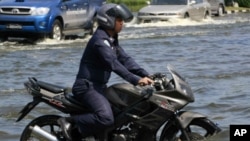Rising floodwaters reached Bangkok’s domestic Don Muang airport Tuesday, hub for the Thai capital’s flood relief efforts and a shelter for thousands of residents who had to flee their inundated homes outside of the city.
As water spilled over airport barriers, airlines suspended operations and authorities made preparations to move thousands of evacuees to another rescue center south of the capital. Continued flooding may keep the main depot from flying emergency supplies to inundated areas in northern Thailand.
Bhitchit Rattakul, director of the Asian Disaster Preparedness Center and a former Bangkok city governor, says authorities are struggling to channel floodwaters into a series of inner-city canals so it can bypass the capital and reach the sea. But connecting the floodways requires cooperation between government entities.
"We must manage to let both sides, the central government and the local [Bangkok city] government, build a barrier beneath the Don Muang airport and direct it to the Premprachakorn Canal," he said. "[In the] lower part of Bangkok and Bangkaen, before arriving at the Victory Monument, there’s [already] lots of [water-engineering] systems built up ready to cope with the water."
Thailand’s most severe flooding in five decades has already inundated more than two-thirds of the country and killed more than 360 people, destroying crops and infrastructure. Government officials say 2.5 million people have been affected.
On Tuesday Prime Minister Yingluck Shinawatra met with the opposition leader Abhisit Vejjajiva, who pledged his moral support to the government during the crisis.
Yingluck's fledgling government has already faced criticism for its handling of the flood crisis, and public opinion polls indicate rising anger over the political infighting.
The Cabinet meanwhile has approved more than $8 billion in loans to help flooded manufacturers, small and medium enterprises and independent businesses. Economists say the economic losses, including damage to major industrial estates, could exceed $6 billion.
The government has declared four days of public holidays at the end of the month to help communities recover and accepted assistance from United States, Japan, China and Australia.
Australian Ambassador James Wise says he is optimistic Thailand will recover but there are concerns over medium-term health issues.
"I think Thailand [has the] capacity to cope with these sorts of things and at least make sure no-one goes hungry, that people that need medical treatment ... get medical treatment," said Wise. "They are responding pretty well. It’s a big clean-up operation. The health issues will change. The rain is still falling and its early stage of the flood, the water is moving. As it subsides, there will be more stagnant water and with that will come health problems."
Public health officials say so far some 750,000 people have been affected by water-borne skin infections. The longer-term concerns lie with the threat of mosquito-borne diseases such as dengue fever.
Across Southeast Asia, the monsoon season has led to almost 800 deaths, especially in Cambodia and Thailand, but also in Burma, Vietnam, Laos and the Philippines. The United Nations says aid workers are struggling to help more than 8 million people across the region, with thousands still receiving little or no assistance.











